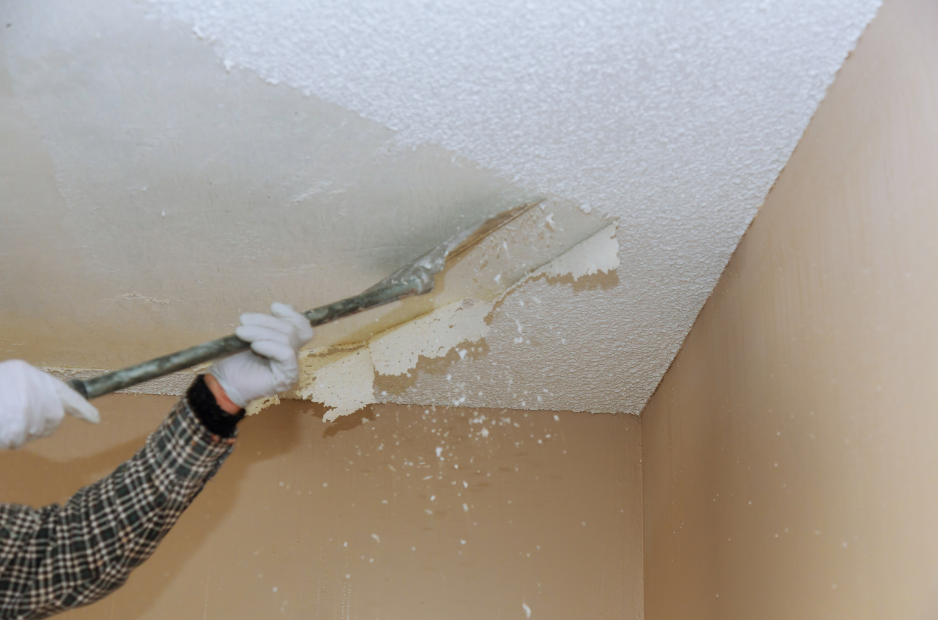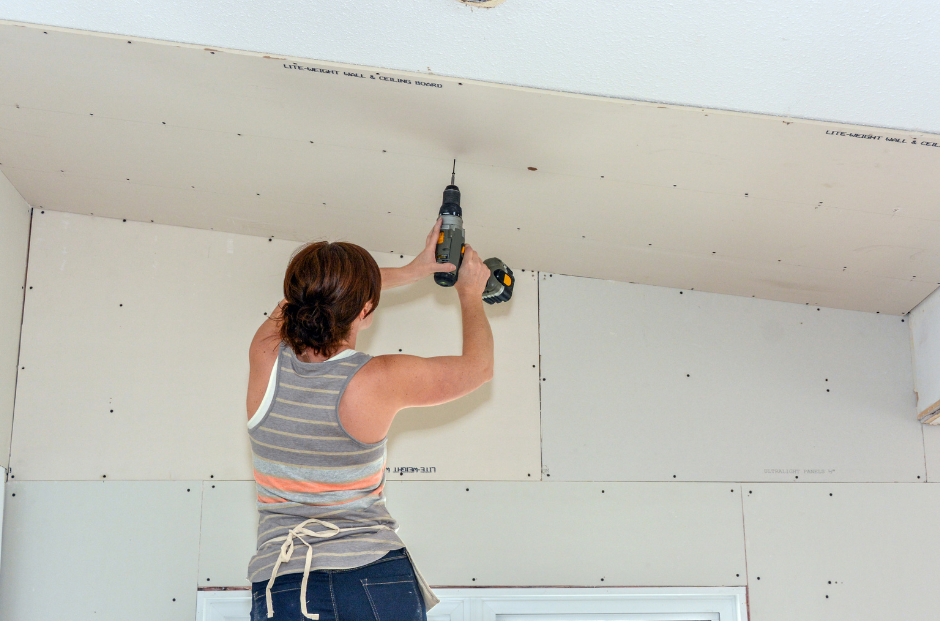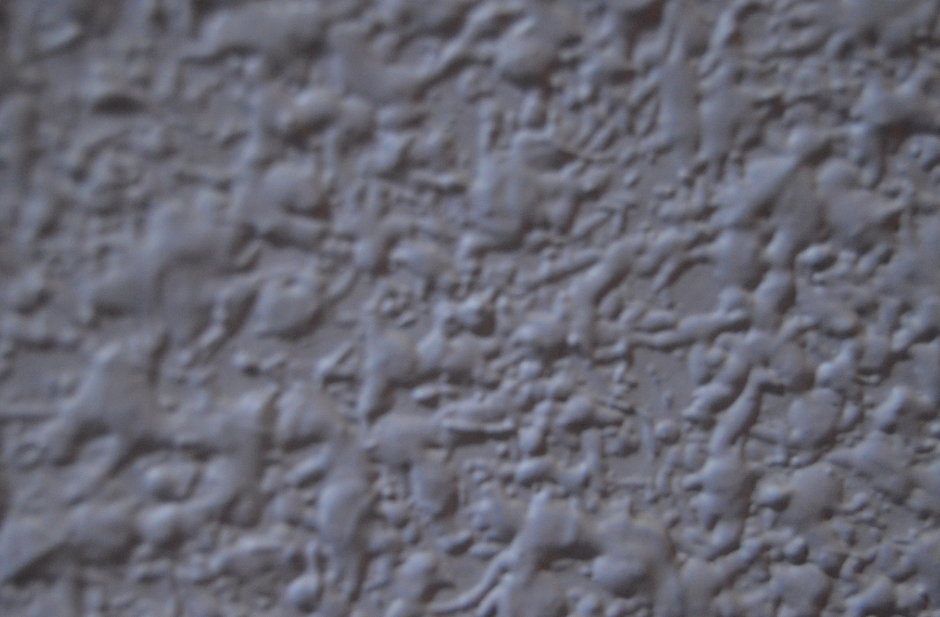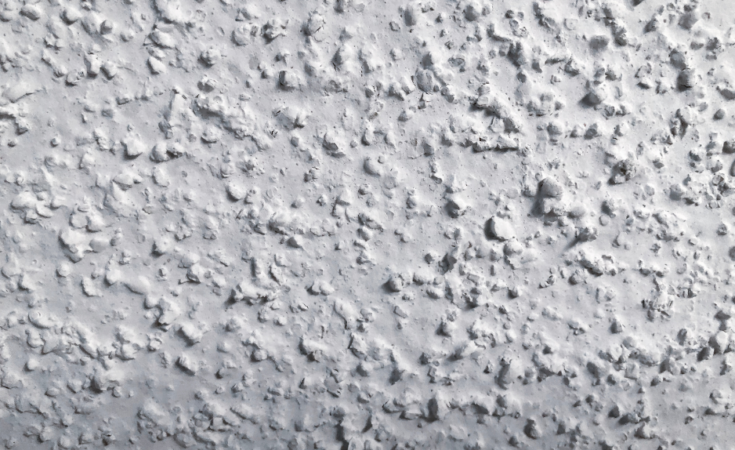Popcorn ceilings are something you may have come across if you’ve been inside a house built during the 20th century. These unique ceilings get their name from their unique popcorn-like texture and, while they are not as desirable today as they once used to be, they do have a few advantages that you might be interested in.
One of the best features of popcorn ceiling is it’s ability to help reduce noise, particularly useful if you’ve got noisy neighbors or are looking to soundproof your basement. But how well does a popcorn ceiling actually work at dampening noise? Should you get one? Are they difficult to install?
Fortunately for you, we have compiled a guide below all about popcorn ceilings and their benefits, how you can get one, and whether they actually work. So, if you’re intrigued about these interesting ceilings, keep reading on.
What Is Popcorn Ceiling And When Was It Popular?
Popcorn ceiling is a type of ceiling that was very popular in residential houses built between the 1930s and 1990s. The ceiling is textured and bumpy, feeling rough to touch, and was mostly found in hallways, bedrooms and basement of houses.
A popcorn ceiling has been textured with styrofoam or stucco, which gives it an uneven appearance that is similar to that of popcorn. The mixture is sprayed onto the ceiling and gives it a unique look, which meant homeowners didn’t need to worry about fixing any gaps, holes or imperfections in it. Popcorn ceiling is also known as stucco ceilings, acoustic ceilings, or cottage cheese ceilings.
They were popular due to a number of factors, but one of the main reasons was because they were cheap and easy to install. It was also found that these ceilings could help to reduce noise by absorbing sound waves, which has meant these ceilings are often still desirable.
Advantages vs. Disadvantages Of Popcorn Ceilings
While popcorn ceiling has gone out of fashion today, it was popular for a reason in the 20th century. Let’s take a look at some of the reasons why it was used so often and why it might still be popular today, and some of the disadvantages that made it fall out of favor.
Advantages
Cheap And Quick To Install
As we mentioned above, one of the biggest advantages to popcorn ceiling and what made it so popular was the fact that it was cheap and easy to install. Instead of having to go to the trouble of covering up imperfections or completing the perfect paint job, popcorn ceiling can be applied quickly and easily. It also dries quickly and prevents you from having to tape and sand drywall for a smooth finish.
Hides Imperfections
Popcorn ceiling wasn’t just cheap when it was first popular, it also did the job of hiding any imperfections on the ceiling. Other than painting the ceiling every now and again, there was no need for homeowners to patch up any holes or fix cracks, because they went unnoticed underneath the rough and bumpy texture of the popcorn. The texture also casts shadows, which could cover up old repair jobs or leaks in the ceiling. This allowed, and still allows, homes to look more “put together” and reduces the amount of DIY that needs to be done.
Help To Reduce Noise
Popcorn ceiling can help to reduce noise thanks to it’s rough and bumpy texture. This texture increases the surface area and therefore more sound is absorbed through the ceiling, which can muffle sounds from noisy neighbors and those in the next room. This is very helpful if you live in an apartment or have rooms in your house with squeaky floors or with lots of traction.

Disadvantages
Difficult To Clean
Popcorn ceiling texture requires more maintenance and upkeep than other ceilings, down to the fact that they have a larger surface area with bumps and grooves. Dirt, debris and cobwebs get trapped in this texture, and it can then be difficult to clean. This is particularly frustrating if you’re not in the habit of cleaning your ceilings!
You can use a duster or a soft head on your vacuum cleaner to help remove dirt from your textured ceiling. However, you must be careful not to push too hard, as parts of the ceiling can break off and create more mess.
Appearance
Let’s face it — popcorn ceiling isn’t the most attractive decor for a home. You want to be your home somewhere you actually want to spend time, so if a popcorn ceiling isn’t going to do this for you, it is worth looking into other sound proofing alternatives.
What’s more, as we mentioned above, popcorn ceiling takes a bit of work to keep looking clean. Not only will you have to remove dirt and debris from the ceiling, but you’ll also have to paint it regularly, which can be a challenge in itself. You cannot paint popcorn ceiling with a regular brush as the stubble will fall off once it is wet, so you need a segmented foam roller to do the job.
Water damage can also disrupt the appearance of popcorn ceiling, causing the bumps to become loose and peel. Therefore, popcorn ceiling is generally not used in kitchens and bathrooms.
Asbestos
One of the main reasons popcorn ceiling fell out of style was due to asbestos. Asbestos was found to be one of the main ingredients in popcorn ceiling mixtures and was banned in the U.S. in 1978 under the Clean Air Act. This is because asbestos can cause mesothelioma (a type of lung cancer) if inhaled.
After this, popcorn ceilings were made of materials such as Styrofoam to create the same bumpy patterns. Of course, you’re not going to need to worry about asbestos if you’re installing a popcorn ceiling nowadays, but if you’ve got one in your home and your house was built in or before the 1970s, you might want to get it checked out.
How Does Popcorn Ceiling Reduce Noise?
If you live a busy apartment block or your home is disturbed by a lot of noise, you might want to install a popcorn ceiling to help reduce the sound level. But how does popcorn ceiling actually help with this problem?
Popcorn ceiling helps to reduce noise by increasing the surface area of the ceiling. The bumps and texture of the ceiling absorb any excess sound and, because there is effectively “more” or the ceiling thanks to this added texture, the noise is spread across a greater area.
It is worth noting that the thicker the popcorn ceiling is, the better it will be at reducing noise. The popcorn ceiling that was used in the 20th century was thick, but popcorn ceiling that is installed today in many houses is not always as thick. This is usually down to the homeowners wanting a more modern look.
Expected Cost vs Expected Results
If you’re looking to install a popcorn ceiling for it’s sound cancelling properties, you’re probably wondering how much it is going to cost and whether it is actually going to be worth it.
Fortunately, popcorn ceiling is cheap to install. While you can get a professional to do it for you, you can do it yourself with spray or roll on popcorn texture, which you should be able to buy at your local hardware store. Prices vary, but you should be able to get a large tub for well under $100. Depending on the quality of the surface you intent to cover, you may need to install good quality drywall panels first – these are around $50 bucks for an 8ft by 4ft panel.

This small price can mean that popcorn ceiling can be worth trying. It’s good at helping to reduce echoes and other general noise, particularly if you need help against noise like common hallways and stairways. The porous surface will absorb sounds and can help to muffle echoes and disruptions.
That being said, popcorn ceiling isn’t completely sound proof and won’t fix all your noise issues. While it can certainly help at reducing noises such as footsteps and loud talking, you may need to search for another alternative if you are dealing with issues such as loud music on a daily basis. Today, there are more effective ways to soundproof a ceiling but better solutions often carry more cost as you would expect.
You should also take into consideration the thickness of your popcorn ceiling — perhaps you already have popcorn ceiling installed, but feel it is not reducing sound levels enough. This could be down to your ceiling not have as much insulation and being too thin.
Other Alternatives
If you don’t feel like popcorn ceiling is for you or you don’t like the way it looks, there are a few other alternatives you can try.
One of the easiest ways to help lessen noise in your home is by adding soft surfaces, such as carpets and curtains. These soft surfaces won’t reflect noise but will absorb it, and will also help to insulate your home, too. You can try adding more cushions and items of soft furniture, such as couches, to your home.
You can insulate your room by adding insulating materials to the walls, too. Materials such as gypsum drywall can help to further absorb sound and can muffle the noise of your neighbors or those in other rooms.
Don’t forget to check your doors, as these could easily be letting in more noise instead of keeping it out. Even with doors closed, some sounds can seep through. This is usually due to the door being made of hollow material, so you might want to replace your doors with solid doors throughout your home.
This can be expensive, though, and if you don’t feel like replacing all the doors, you could try adding weather stripping around them. This will fill in the slight space between your door and its frame where sounds tend to slip through. If you want to check out some of these other methods, check out our guides on how to soundproof a room and how to soundproof a door.

Popcorn Ceiling FAQ’s
How do I install popcorn ceiling?
Popcorn ceiling is fairly easy to install on your own, although it can be time consuming. Before you get started with this DIY project, there are a few things you should do. Remove all the ceiling accessories first, including light fixtures and ceiling fans, as these can get damaged when you are spraying on the popcorn ceiling. Don’t forget to clean the ceiling first either, as have a clean and smooth ceiling will ensure the stucco sticks to it better.
Place down drop cloths or plastic sheeting on the ground to protect the rest of your room. Prime the ceiling with a stain-blocking primer from any home improvement store, then cover and leave to dry for 24 hours.
Once the primer is dry, it is time to apply the popcorn. Open the windows and make sure the room is well ventilated before mixing your popcorn. Mix the popcorn ceiling spray (a 13 gallon bag) with 2 gallons of water until it looks like cottage cheese. Always ensure it isn’t too thin, otherwise it won’t stick.
Then fill a spray gun with the popcorn mixture and begin spraying your ceiling in an even back and forth motion. If you have hard to reach areas you can use a trowel to reach them and make sure you cover the ceiling evenly.
Once it has been applied, you’ll have to leave it for 24 hours to dry before you decide to paint it. You could also add a glaze, which will help the stucco to stick together.
How do I repair my popcorn ceiling?
Overtime, popcorn ceiling can become damaged and may need to be repaired. Repairing your popcorn ceiling is similar to installing it. You should first scrape off all the bumps surrounding the damaged section and sand it down. Sanding it down with make sure the ceiling is smooth so drywall plaster can then be applied. After this, sand it down again, and then spray on the popcorn. You can then paint it once it has dried.
Can I remove popcorn ceiling if I don’t like it?
If you decide you don’t like your popcorn ceiling, removing it is actually very easy. If the popcorn ceiling is unpainted, all you need to do is spray the ceiling with water and then scrape off the popcorn with a utility drywall knife or scraper. This can be a messy job, so make sure you put down cloths to prevent it from going everywhere. If the ceiling is painted, it can be a little more tricky, and a stripping product may be required.
You can have your popcorn ceiling removed by a professional if you don’t fancy tackling the job yourself. You can expect to pay a popcorn ceiling removal professional around $1 per square foot to have the texture removed and the ceiling retextured.
It is important to remember that if you house was built before 1977, the stucco ceiling may contain asbestos. In this case, you should never try to tackle removing the ceiling yourself, and should always get a professional.
If you don’t want to go through the hassle of scraping the ceiling off, you could simply cover it with a drywall layer for ease. However, if there is a chance it contains asbestos, consult a professional.
Popcorn Ceiling Summary
While popcorn ceiling is not the most sought after ceiling nowadays, it can be a great addition to a room for extra soundproofing. Pretty simple and cheap to install, it will help to absorb noise from nearby apartments and noisy neighbors. This ceiling can also help to hide cracks and damage in the paintwork, so you won’t have to worry about imperfections. Although the textured popcorn can be difficult to clean and dirt and dust can accumulate, you might just find it is the ceiling that keeps your house quiet. Do you think you’ll install popcorn ceiling?




